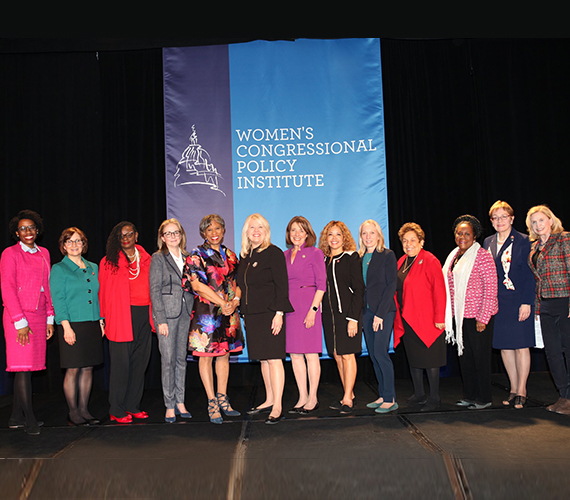Diversity in the Financial Services Industry Focus of Hearing
November 29, 2023
SOURCE: Women’s Congressional Policy Institute
On July 15, the House Financial Services Subcommittee on Oversight and Investigations held a hearing entitled, “Diversity in the Financial Services Industry and Access to Capital for Minority-Owned Businesses: Challenges and Opportunities.” Chair Sue Kelly (R-NY) opened the hearing, saying, “A simple snapshot of our country’s current employment composition displays some disparities among certain populations, particularly with regard to women and minorities. As a society, it is our responsibility to encourage the diversity in financial services that reflects the makeup of our country.”
Noting that there are currently more than 2 million Latino businesses in the U.S., Ana Maria Fernandez Haar, chair of the board of directors for the New America Alliance, said that Latinos are underrepresented in leadership and executive positions within the financial services industry. She cited the 2003-04 Corporate Governance Study by the Hispanic Association on Corporate Responsibility, which found that Latinos served on the boards of only 166 Fortune 1000 companies. “Furthermore, when measuring the number of director positions occupied by Latinos, out of 10,314 positions, Latinos occupy only 202 seats, or 1.97 percent,” she said. “The Latino population constitutes about 15 percent of the U.S.” However, she said, “the U.S. securities industry Latino workforce constitutes 4.7 percent.” Ms. Haar made several recommendations on improving Latino participation in executive level positions: 1) have inclusive and diverse leadership teams, 2) broaden the composition of corporate boards, 3) use the Sarbanes-Oxley reforms to increase diversity by appointing minorities as independent directors, 4) develop an infrastructure to guide board appointments and hiring initiatives, and 5) have elected and appointed officials publicly promote the importance of corporate diversity.
Theresa Hammond, chair of the Department of Accounting at the Wallace E. Carroll School of Management at Boston College, spoke to the lack of African American Certified Public Accountants (CPAs). “Fewer than one percent of CPAs are African-American,” she said, adding that in 1996, one in 1,000 partners in major accounting firms were African American. Ms. Hammond cited a number of reasons for the disparity, including a history of racial discrimination, an absence of mentors, educational disadvantages for African American students, lack of African American accounting professors, lack of African American-owned CPA firms, and CPA firm culture. Stating that the decline of African Americans in the CPA industry has largely gone unnoticed, she pointed to the trend of placing “the participation of African Americans, Latinos, Asian Americans, and white women together under one group” when firms consider diversity programs. “The largest firms developed targeted programs to retain and promote women…In the meantime, African-American recruitment, retention, and promotion seem to have stagnated, which does not provoke widespread concern.”
Managing Director of the Atlanta office of Korn/Ferry International Michael Kennedy detailed the firm’s diversity practice, which was started in 1998 to assist clients in addressing their diversity needs. Saying that the status of diversity within financial services “is a story of good news/not so good news,” Mr. Kennedy cited Korn/Ferry’s 30th Annual Board of Directors survey of Fortune 1000 companies. “The percentage of corporations with minority Board members rose from 65 percent in 2000 to 71 percent in 2002. Female Board representation rose from 74 percent in 2000 to 79 percent in 2002.” He went on to say that a November survey of corporate officers and top earners by Catalyst found “women represented 15.7 percent of corporate officers in America’s 500 largest companies, up from 12.5 percent in 2000 and 8.7 percent in 1995.”
Despite these improvements, he said, “The financial services industry is still viewed as lacking significant diversity. Due to the continued consolidation within the industry, we have witnessed several talented women and people of color at the senior and middle levels who have left their organizations…In addition, as the economy weakened, women and people of color were particularly impacted in the middle management ranks.” Mr. Kennedy stated that women and people of color are particularly underrepresented in certain sectors such as asset management, investment banking, private equity/venture capital, and wealth management. Korn/Ferry’s most recent diversity study, Best Practices for Diversity, found several factors that contribute to the success of recruiting and retaining diverse talent: 1) the most successful organizations had CEOs who were “passionately” committed and had “instituted a diversity component as part of the bonus compensation for his/her reports,” 2) larger, more global firms were more successful than mid-sized national or regional firms, and 3) internships were a more effective strategy for recruiting minorities than targeting minority organizations.
President of the Securities Industry Association (SIA) Marc Lackritz told the subcommittee that the percentage of women and minorities in securities industry management positions is increasing. “Twenty-seven percent of those employees categorized as ‘executive management’ are either women or minorities, as compared with 20 percent in 2001…Thirty-three percent of the investment bankers in large firms were women or minorities, a nine-percent increase from 2001.” In an effort to address concern regarding diversity, the SIA established a Diversity Committee that began offering a “Leadership Award” in 2002 to “encourage innovation in the policies and programs that firms use to attract and retain minority employees.” The Diversity Committee also developed a Diversity Resource Guide and introduced diversity into the core curriculum of the Securities Industry Institute at the Wharton School.
Joanne Hanley, president of Women in Housing and Finance, Inc. (WHF), discussed her organization’s efforts to expand opportunities for women to advance in the financial services industry. “WHF carries out our mission by offering substantive educational programs on the current issues facing housing and financial services, usually through lunch-time programs that fit into a busy professional’s schedule.” Specifically, WHF hosts a monthly luncheon, brown bag lunches, and all-day symposiums on issues of concern to its members. “Our special events highlight policy leaders of special interest to our members and include congressional receptions, women leaders’ breakfasts, and the regulators’ reception. The programs enable members to network in informal settings with prominent policy leaders and role models,” she said.
Ms. Hanley also detailed WHF’s “on-the-job leadership training that occurs as a result of the need to create and maintain a leadership structure for the organization. Through assuming leadership roles in WHF, our members have learned: to chair committees and task forces, to organize the programs, to speak at symposia and brown bag lunches, and to serve as executive officers and Board members.” Additionally, WHF provides a Protégé Program that provides in-depth training over a six-month period on management and leadership skills. Speaking to the issue of diversity within the organization, Ms. Hanley said, “WHF early on made the decision to open our membership to men. Currently, one-third of our membership are men and one-third of our Board of Directors are men. So, should we remain focused on women?” After lengthy debate on the issue, she said, “We concluded that the need for career advancement remains for women who face obstacles in the financial services and housing industry, and we reaffirmed our focus on women’s success as a key element of our organization. While our leadership training programs are open to men, the perspective is on the way women lead and the strategies that bring success to women in the workplace.”

